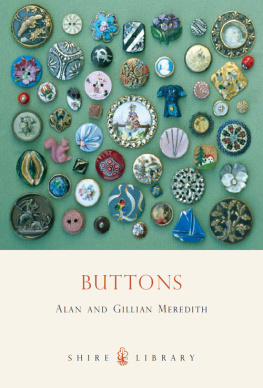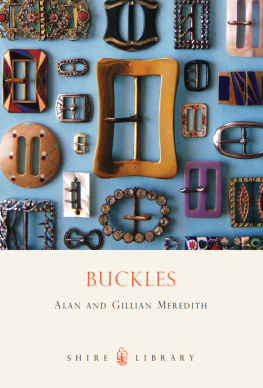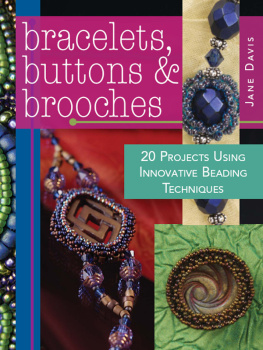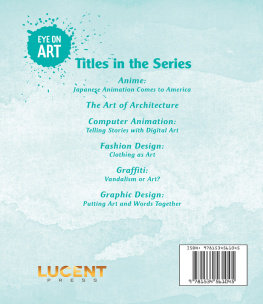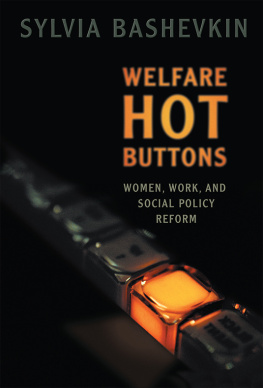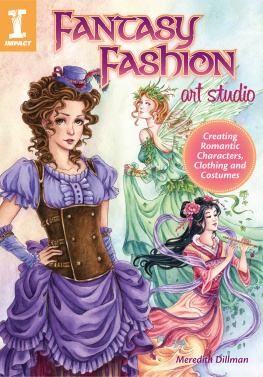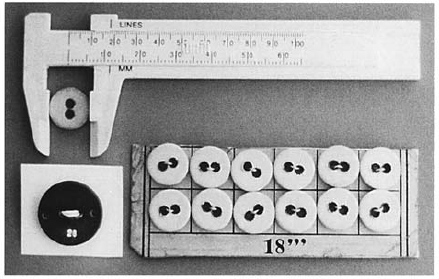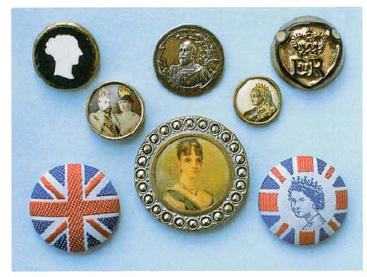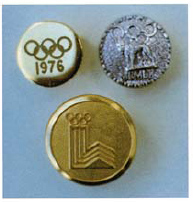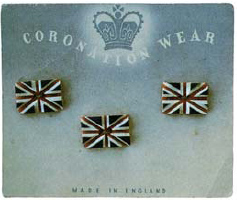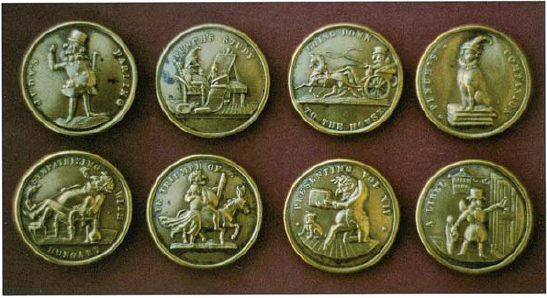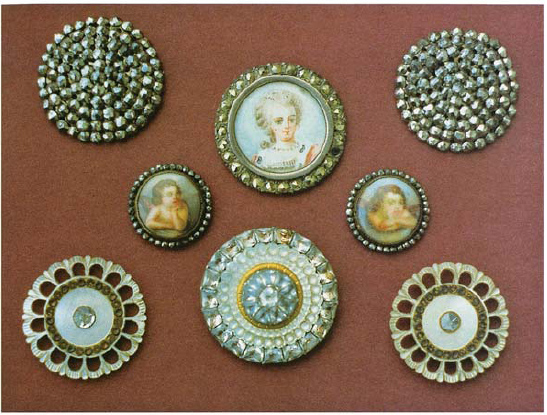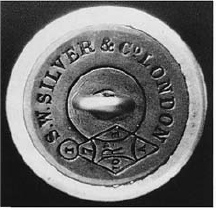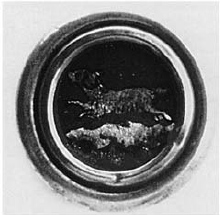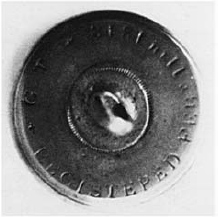BUTTONS
Alan and Gillian Meredith
A selection of nineteenth- and twentieth-century enamels.
Contents
A line measure above a card of linen buttons, showing the size and abbreviation for lines. Buttons are measured in lines, with 40 lines to the inch. Each of the buttons on the card measures 18 lines. The contemporary composition button (bottom left) shows the incised line measurement, 28, on the back.
Royal commemoratives. (Top row, left to right) Queen Victoria, young head, white glass set into black glass mounted in brass; Edward VII, stamped metal, gilded; Elizabeth IIs coronation, lustred moulded glass. (Middle row, left to right) George Vs and Queen Marys coronation, 1911, waistcoat button; Queen Victoria, old head, glove button. (Bottom row, left to right) Union Jack woven by J. & J. Cash Ltd, Coventry, 1952; Queen Alexandra, imitation cut steel edge; Elizabeth II, woven by J. & J. Cash Ltd.
Olympic Games: top left, Montreal 1976; top right, Rome l960; bottom, Los Angeles 1984.
George VIs coronation, 1937, on the original sales card.
Punch cartoon buttons, c.1850, showing famous cartoons of the day.
(Top right and left) Eighteenth-century cut steel set into brass. (Bottom left and right) Eighteenth-century pearl set with diamante. (Top centre) Hand-painted miniature under glass surrounded by marcasite set in silver, c.1800. (Bottom centre) Eighteenth-century diamante and pearl set in silver. (Middle left and right) Eighteenth-century painted porcelain discs surrounded by cut steels.
Introduction
Buttons, uniquely for such a small collectable item, cover the full spectrum of ages and materials. Those who collect them usually experience an additional pleasure engendered by such personal, much handled, utilitarian objects. Studying them entails research into just about every known material and every type of manufacturing technique and throws light on fashion trends, the clothing industry and social history in general.
With such a wide scope available, this volume is restricted to buttons made for use in the British Isles on informal everyday clothes. Uniform buttons for military, civilian, livery or sporting apparel form a subject on their own.
You may be drawn to collecting buttons for one of many reasons. Their small size is a distinct advantage when considering storage and forms an essential part of their charm. Every art and craft has been used in button decoration and the minute scale necessary brings a sense of wonder at the skill involved. A box of buttons, the traditional rainy day toy when visiting Granny, can be just as therapeutically entrancing to an adult wishing to escape the strains of life.
Whatever the reason for your interest we hope this book will give you a brief insight into the vast world of the humble little button.
Dating buttons
One of the first questions usually asked about a button is How old is it? In answering, there are a number of imponderables, all of which must be borne in mind.
The only buttons that can be dated with total accuracy are of silver or gold and carry an original hallmark incorporating a date letter. There are a rare few that carry a kite mark, and a few which carry a date or commemorative design. Back marks of a button manufacturer or tailor can give an indication of the age of the button.
Dating unmarked buttons requires careful consideration of the material used and the manner of its use. Close examination with a magnifying glass is always recommended. With this precept in mind it is an advantage to have more than one example of a set so that detailed comparisons can be made of the construction and any decoration, mould marks or natural grain lines.
Kite mark on a black glass button giving a date of June 1868.
Kite mark giving a date of 7th December 1872.
Both sides of a button with a foil picture under glass on the front. The back mark reads Registered Feb 11th. 1848 G.T.
The industrial revolution of the eighteenth century introduced manufacturing processes which resulted in uniformity, replacing the unevenness and individuality of hand operations.
Some vogues in button ornamentation passed, never to return, whereas others became classics and were adapted only slightly by each generation. Clothing fashion may only guide us in the dating process because a favoured style can become a lifelong habit after newer fashions have been introduced. Small buttons were set close together to create a neatly fitted appearance to a bodice or sleeve. Large buttons could be used on loose, flowing styles as the width of the buttonhole provided a flexible dimension to the garment.
Ready-to-wear clothing has come to dominate the trade only since the Second World War. Before then personal tailoring from commercial establishments or home dressmakers allowed for a wide market for the button manufacturers. Buttons could be expensive items, often chosen with as much care as would be taken over a piece of jewellery, and selected for their individual appeal rather than because they matched a particular article of clothing. They were never thrown away, but kept in the button box, a tradition that persisted through many generations. Buttons with long shanks were generally intended for use on the thick cloth of gentlemens clothes. Once in the family button box, the original purpose of any type of button was forgotten. This recycling can present a collector with a very misleading provenance for a button.
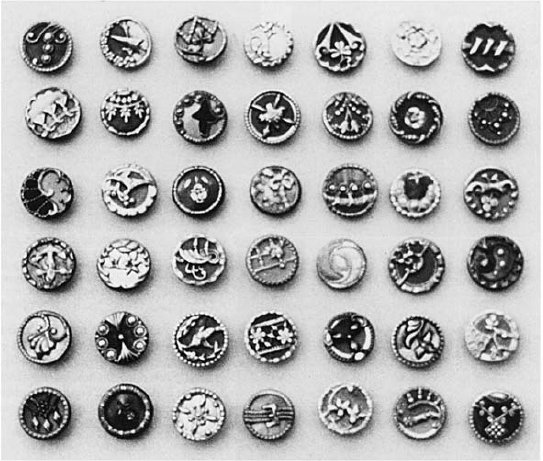
Austrian tinies, the collectors name for this type of late-nineteenth-century button, although they were also made elsewhere. All are 3/8 inch (1 cm), made up of decorative layers of various materials held together by the rim with a japanned back and metal shank.

